Unique Pre-Earthquake Deformation Patterns in the Spatial Domains from GPS in Taiwan
Abstract
:1. Introduction
2. Theory and Methodology
3. Examples and Results
4. Discussion
5. Conclusions
Author Contributions
Funding
Acknowledgments
Conflicts of Interest
References
- Reid, H.F. The mechanics of the earthquake. In The California Earthquake of April 18, 1906: Report of the State Earthquake Investigation Commission; Carnegie Institution of Washington Publication: Washington, DC, USA, 1910. [Google Scholar]
- Reilinger, R.; Ergintav, S.; Bürgmann, R.; McCluskey, S.; Lenk, O.; Barka, A.; Gurkan, O.; Hearn, E.; Feigl, K.L.; Cakmak, R.; et al. Coseismic and postseismic fault slip for the 17 August 1999, M = 7.5, Izmit, Turkey Earthquake. Science 2000, 289, 1519–1524. [Google Scholar] [CrossRef]
- Reilinger, R.; McClusky, S.; Vernant, P.; Lawrence, S.; Ergintav, S.; Cakmak, R.; Ozener, H.; Kadirov, F.; Guliev, I.; Nadariya, M.; et al. GPS constraints on continental deformation in the Africa-Arabia-Eurasia continental collision zone and implications for the dynamics of plate interactions. J. Geophys. Res 2006, 111, B05411. [Google Scholar] [CrossRef]
- Bouchon, M.; Toksöz, M.N.; Karabulut, H.; Bouin, M.P.; Dietrich, M.; Aktar, M.; Edie, M. Space and time evolution of rupture and faulting during the 1999 Izmit (Turkey) earthquake. Bull. Seismol. Soc. Am. 2002, 92, 256–266. [Google Scholar] [CrossRef]
- Vernant, P.; Nilforoushan, F.; Hatzfeld, D.; Abbassi, M.R.; Vigny, C.; Masson, F.; Nankali, H.; Martinod, J.; Ashtiani, A.; Bayer, R.; et al. Present-day crustal deformation and plate kinematics in the Middle East constrained by GPS measurements in Iran and northern Oman. Geophys. J. Int. 2004, 157, 381–398. [Google Scholar] [CrossRef] [Green Version]
- Mahmoud, S.; Reilinger, R.; McClusky, S.; Vernant, P.; Tealeb, A. GPS evidence for northward motion of the Sinai Block Implications for E. Mediterranean tectonics. Earth Planet. Sci. Lett. 2005, 238, 217–224. [Google Scholar] [CrossRef]
- Langbein, J.; Murray, J.R.; Snyder, H.A. Coseismic and initial postseismic deformation from the 2004 Parkfield, California earthquake, observed by GPS, EDM, creepmenters, and borehole strainmeters. Bull. Seismol. Soc. Am. 2006, 96, S304–S320. [Google Scholar] [CrossRef]
- Rolandone, F.; Dreger, D.; Murray, M.; Bürgmann, R. Coseismic slip distribution of the 2003 M 6.6 San Simeon earthquake, California, determined from GPS measurements and seismic waveform data. Geophys. Res. Lett. 2006, 33, L16315. [Google Scholar] [CrossRef]
- McClusky, S.; Reilinger, R.; Mahmoud, S.; Ben Sari, D.; Tealeb, A. GPS constraints on Africa (Nubia) and Arabia plate motions. Geophys. J. Int. 2003, 155, 126–138. [Google Scholar] [CrossRef] [Green Version]
- Prawirodirdjo, L.; Bock, Y. Instantaneous global plate motion model from 12 years of continuous GPS observations. J. Geophys. Res. 2004, 109, B08405. [Google Scholar] [CrossRef]
- Wernicke, B.; Davis, J.L.; Bennett, R.A.; Normandeau, J.E.; Friedrich, A.M. Tectonic implications of a dense continuous GPS velocity field at Yucca Mountain, Nevada. J. Geophys. Res. 2004, 109, B12404. [Google Scholar] [CrossRef] [Green Version]
- Geirsson, H.; Arnadottir, T.; Volksen, C.; Jiang, W.; Sturkell, E.; Villemin, T.; Einarsson, P.; Sigmundsson, F.; Stefaánsson, R. Current plate movements across the Mid-Atlantic Ridge determined from 5 years of continuous GPS measurements in Iceland. J. Geophys. Res. 2006, 111, B09407. [Google Scholar] [CrossRef] [Green Version]
- Norabuena, E.; Dixon, T.H.; Schwartz, S.; DeShon, H.; Newman, A.; Protti, M.; Gonzalez, V.; Dorman, L.; Flueh, E.R.; Lundgren, P.; et al. Geodetic and seismic constraints on some seismogenic zone processes in Costa Rica. J. Geophys. Res. 2004, 109, B11403. [Google Scholar] [CrossRef]
- Gahalaut, V.K.; Nagarajan, B.; Catherine, J.K.; Skumar, S. Constraints on 2004 Sumatra Andaman earthquake rupture from GPS measurements in Andaman-Nicobar Islands. Earth Planet. Sci. Lett. 2006, 242, 365–374. [Google Scholar] [CrossRef]
- Wang, K. Elastic and Viscoelastic Models of Crustal Deformation in Subduction Earthquake Cycles. In The Seismogenic Zone of Subduction Thrust Faults, MARGINS Theoretical and Experimental Earth Science Series; Dixon, T.H., Moore, J.C., Eds.; Columbia University Press: New York, NY, USA, 2007; pp. 545–575. [Google Scholar]
- van Dam, T.; Wahr, J.; Milly, P.C.D.; Shmakin, A.B.; Blewitt, G.; Lavallee, D.; Larson, K.M. Crustal displacements due to continental water loading. Geophys. Res. Lett. 2001, 28, 651–654. [Google Scholar] [CrossRef] [Green Version]
- Blewitt, G.; Lavallee, D. Effect of annual signals on geodetic velocity. J. Geophys. Res. 2002, 107, 2145. [Google Scholar] [CrossRef] [Green Version]
- Ray, J.; Altamimi, Z.; Collilieux, X.; van Dam, T. Anomalous Harmonics in the spectra of GPS position estimates. GPS Solut. 2008, 12, 55–64. [Google Scholar] [CrossRef]
- Yeh, T.K.; Hwang, C.; Xu, G. GPS height and gravity variations due to ocean tidal loading around Taiwan. Surv. Geophys. 2008, 29, 37–50. [Google Scholar] [CrossRef]
- Bracewell, R.N. The Fourier Transform and Its Applications, 3rd ed.; McGraw-Hill: Boston, MA, USA, 2000; p. 624. [Google Scholar]
- Farge, M. Wavelet transforms and their applications to turbulence. Annu. Rev. Fluid Mech. 1992, 24, 395–457. [Google Scholar] [CrossRef]
- Chen, C.H.; Yeh, T.K.; Liu, J.Y.; Wang, C.H.; Wen, S.; Yen, H.Y.; Chang, S.H. Surface Deformation and Seismic Rebound: Implications and applications. Surv. Geophys. 2011, 32, 291–313. [Google Scholar] [CrossRef]
- Huang, N.E.; Shen, Z.; Long, S.R.; Wu, M.C.; Shih, H.H.; Zheng, Q.; Yen, N.-C.; Tung, C.C.; Liu, H.H. The empirical mode decomposition and the Hilbert spectrum for nonlinear and non-stationary time series analysis. Proc. R. Soc. Lond. Ser. A 1998, 454, 903–995. [Google Scholar] [CrossRef]
- Huang, N.E.; Shen, Z.; Long, S.R.; Shen, S.S.P.; Hsu, N.H.; Xiong, D.; Qu, W.; Gloersen, P. On the establishment of a confidence limit for the empirical mode decomposition and Hilbert spectral analysis. Proc. R. Soc. Lond. Ser. A 2003, 459, 2317–2345. [Google Scholar] [CrossRef]
- Huang, N.E.; Wu, Z. A review on Hilbert-Huang transform: Method and its applications to geophysical studies. Rev. Geophys. 2008, 46, RG2006. [Google Scholar] [CrossRef] [Green Version]
- Bolt, B.A. Earthquake; W.H. Freeman and Company: New York, NY, USA, 1993; p. 331. [Google Scholar]
- Robinson, R.; McGinty, P.J. The enigma of the Arthur’s Pass, New Zealand, earthquake 2. The aftershock distribution and its relation to regional and induced stress field. J. Geophys. Res. 2000, 105, 16139–16150. [Google Scholar] [CrossRef]
- Chéry, J. Geodetic strain across the San Andreas Fault reflects elastic plate thickness variations (rather than fault slip rate). Earth Planet. Sci. Lett. 2008, 269, 352–365. [Google Scholar] [CrossRef]
- Pérouse, E.; Vernant, P.; Chéry, J.; Reilinger, R.; McClusky, S. Active surface deformation and sub-lithospheric processes in the western Mediterranean constrained by numerical models. Geology 2010, 38, 823–826. [Google Scholar] [CrossRef]
- Saastamoinen, J. Contributions to the theory of atmospheric refraction. Bull. Geod. 1973, 107, 13–34. [Google Scholar] [CrossRef]
- Yeh, T.K.; Shih, H.C.; Wang, C.S.; Choy, S.; Chen, C.H.; Hong, J.S. Determining the precipitable water vapor thresholds under different rainfall strengths in Taiwan. Adv. Space Res. 2018, 61, 941–950. [Google Scholar] [CrossRef]
- Yeh, T.K.; Hwang, C.; Xu, G.; Wang, C.S.; Lee, C.C. Determination of global positioning system (GPS) receiver clock errors: Impact on positioning accuracy. Meas. Sci. Technol. 2009, 20, 075105. [Google Scholar] [CrossRef]
- Chen, C.H.; Wen, S.; Liu, J.Y.; Hattori, K.; Han, P.; Hobara, Y.; Wang, C.H.; Yeh, T.K.; Yen, H.Y. Surface displacements in Japan before the 11 March 2011 M9.0 Tohoku-Oki earthquake. J. Asian Earth Sci. 2014, 80, 165–171. [Google Scholar] [CrossRef]
- Shin, T.C.; Kuo, K.W.; Leu, P.L.; Tsai, C.H.; Jiang, J.S. Continuous CWB GPS array in Taiwan and applications to monitoring seismic activity. Terr. Atmos. Ocean. Sci. 2011, 22, 521–533. [Google Scholar] [CrossRef]
- Yeh, T.K.; Chan, S.L.; Shih, H.C.; Su, K.C. Ground-based GPS remote sensing for precipitable water vapor: A case study of the heat-island effect in Taipei. Terr. Atmos. Ocean. Sci. 2019, 30, 151–160. [Google Scholar] [CrossRef] [Green Version]
- Booth, D.C.; Crampin, S.; Lovell, J.H.; Chiu, J.M. Temporal changes in shear wave splitting during an earthquake swarm in Arkansas. J. Geophys. Res. 1990, 95, 11151–11164. [Google Scholar] [CrossRef]
- Winterstein, D.F.; Meadows, M.A. Shear-wave polarizations and subsurface stress directions at Lost Hills field. Geophysics 1991, 56, 1331–1348. [Google Scholar] [CrossRef]
- Crampin, S. The fracture criticality of crustal rocks. Geophys. J. Int. 1994, 118, 428–438. [Google Scholar] [CrossRef]
- Crampin, S.; Volti, T.; Stefansson, R. A successfully stress-forecast earthquake. Geophys. J. Int. 1999, 138, F1–F5. [Google Scholar] [CrossRef] [Green Version]
- Chen, C.H.; Wang, C.H.; Wen, S.; Yeh, T.K.; Lin, C.H.; Liu, J.Y.; Yen, H.Y.; Lin, C.; Rau, R.J.; Lin, T.W. Anomalous frequency characteristics of groundwater level before major earthquake in Taiwan. Hydrol. Earth Syst. Sci. 2013, 17, 1693–1703. [Google Scholar] [CrossRef] [Green Version]
- Dobrovolsky, I.P.; Zubkov, S.I.; Miachkin, V.I. Estimation of the size of earthquake preparation zones. Pure Appl. Geophys. 1979, 117, 1025–1044. [Google Scholar] [CrossRef]
- Chen, C.H.; Wen, S.; Yeh, T.K.; Wang, C.H.; Yen, H.Y.; Liu, J.Y.; Hobara, Y.; Han, P. Observation of surface displacements from GPS analyses before and after the Jiashian earthquake (M = 6.4) in Taiwan. J. Asian Earth Sci. 2013, 80, 662–671. [Google Scholar] [CrossRef]
- Molchan, G.M. Structure of optimal strategies in earthquake prediction. Tectonophysics 1991, 193, 267–276. [Google Scholar] [CrossRef]
- Han, P.; Hattori, K.; Zhuang, J.; Chen, C.H.; Liu, J.Y.; Yoshida, S. Evaluation of ULF seismo-magnetic phenomena in Kakioka, Japan by using Molchan’s error diagram. Geophys. J. Int. 2017, 404, 482–490. [Google Scholar] [CrossRef]
- Chen, C.H.; Tang, C.C.; Cheng, K.C.; Wang, C.H.; Wen, S.; Lin, C.H.; Wen, Y.Y.; Meng, G.; Yeh, T.K.; Jan, J.C.; et al. Groundwater-strain coupling before the 1999 Mw 7.6 Taiwan Chi-Chi earthquake. J. Hydrol. 2015, 524, 378–384. [Google Scholar] [CrossRef]
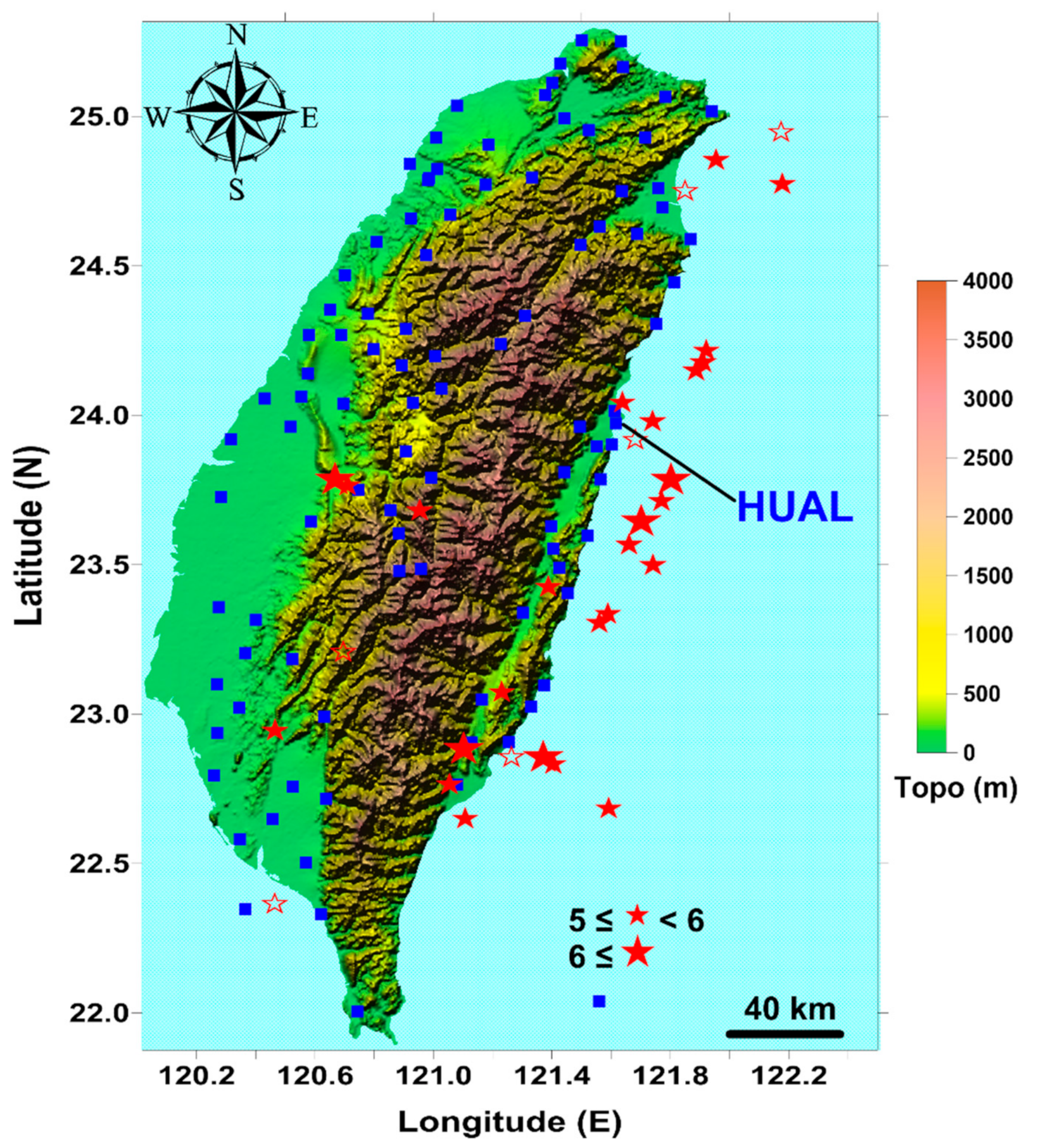

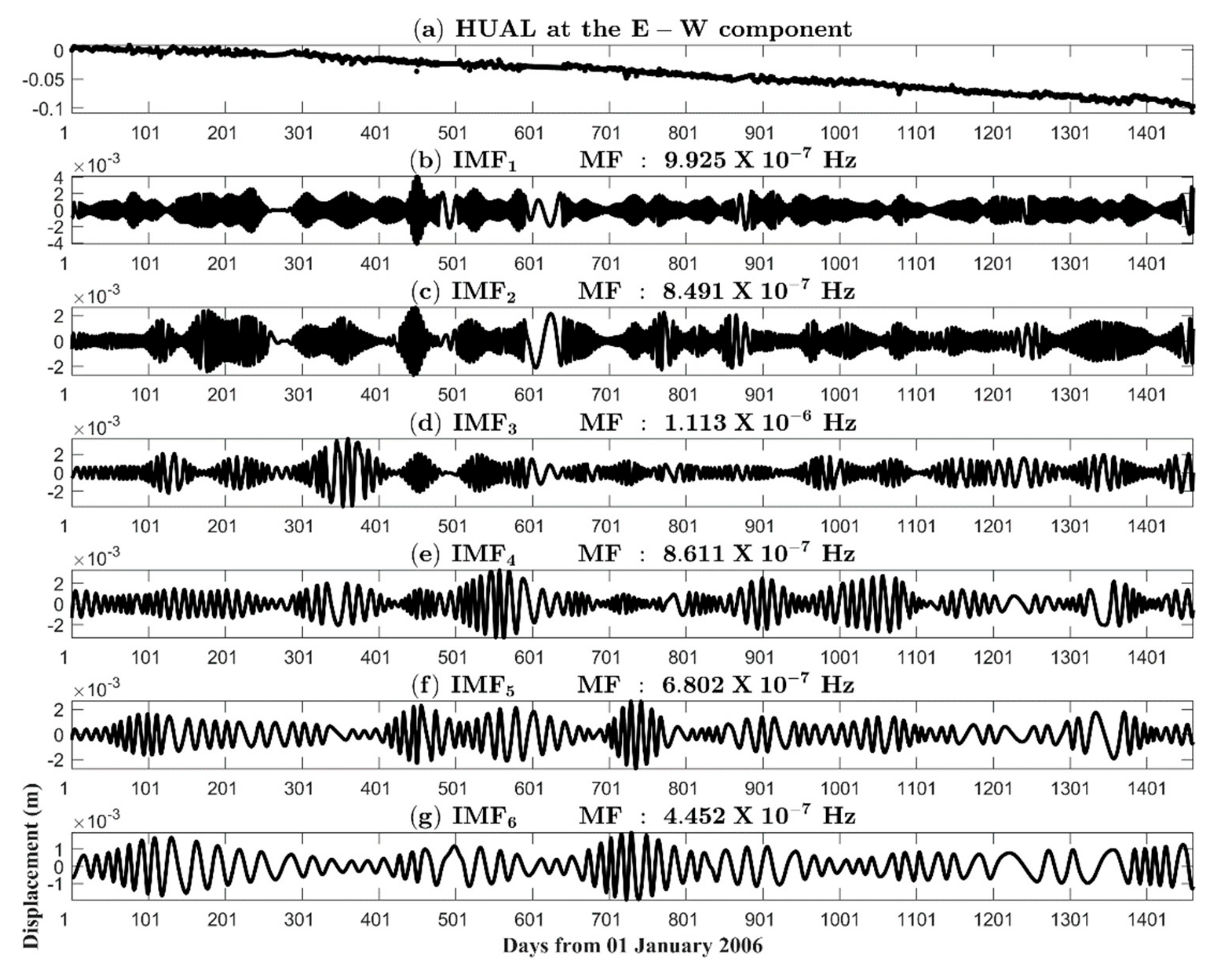
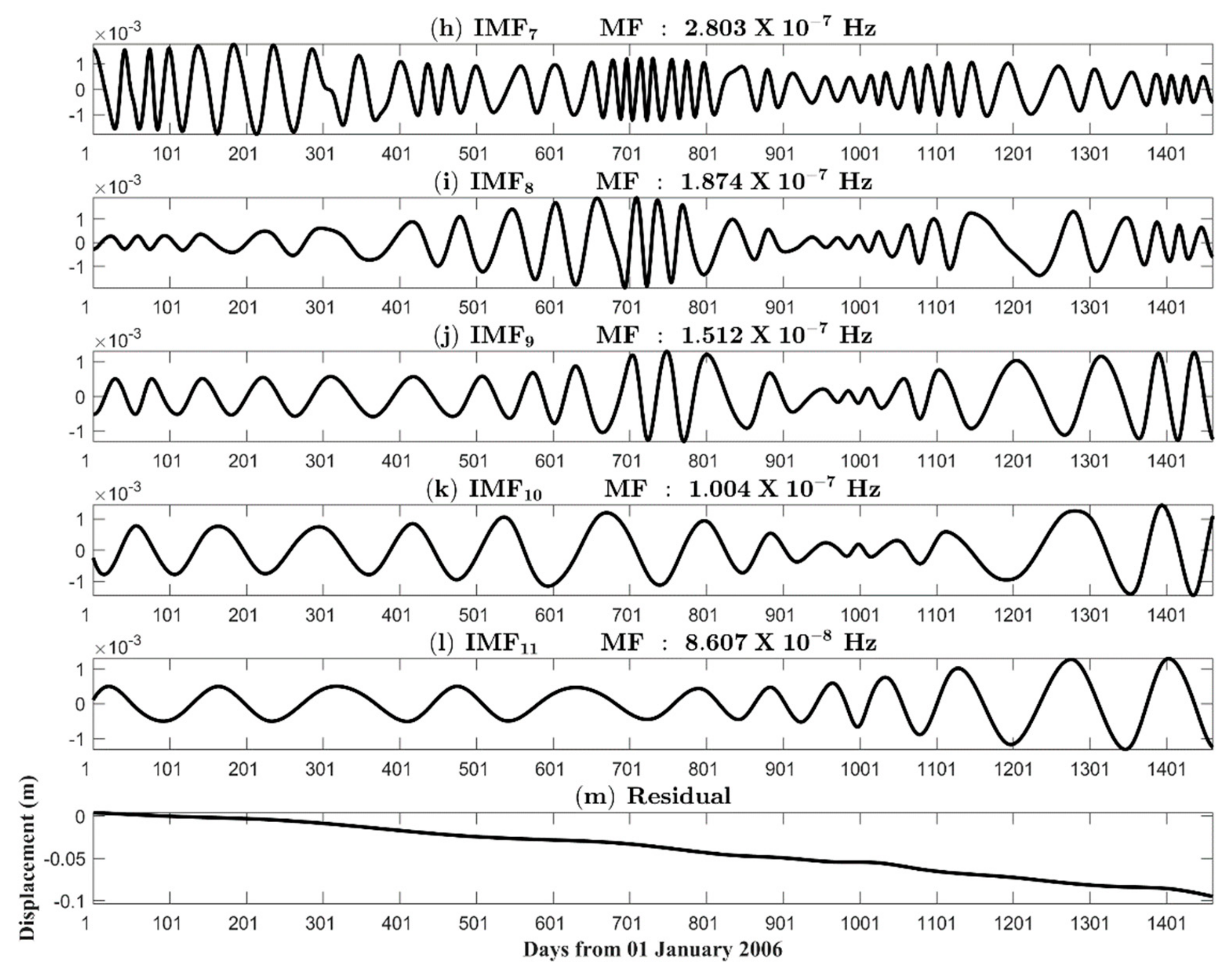


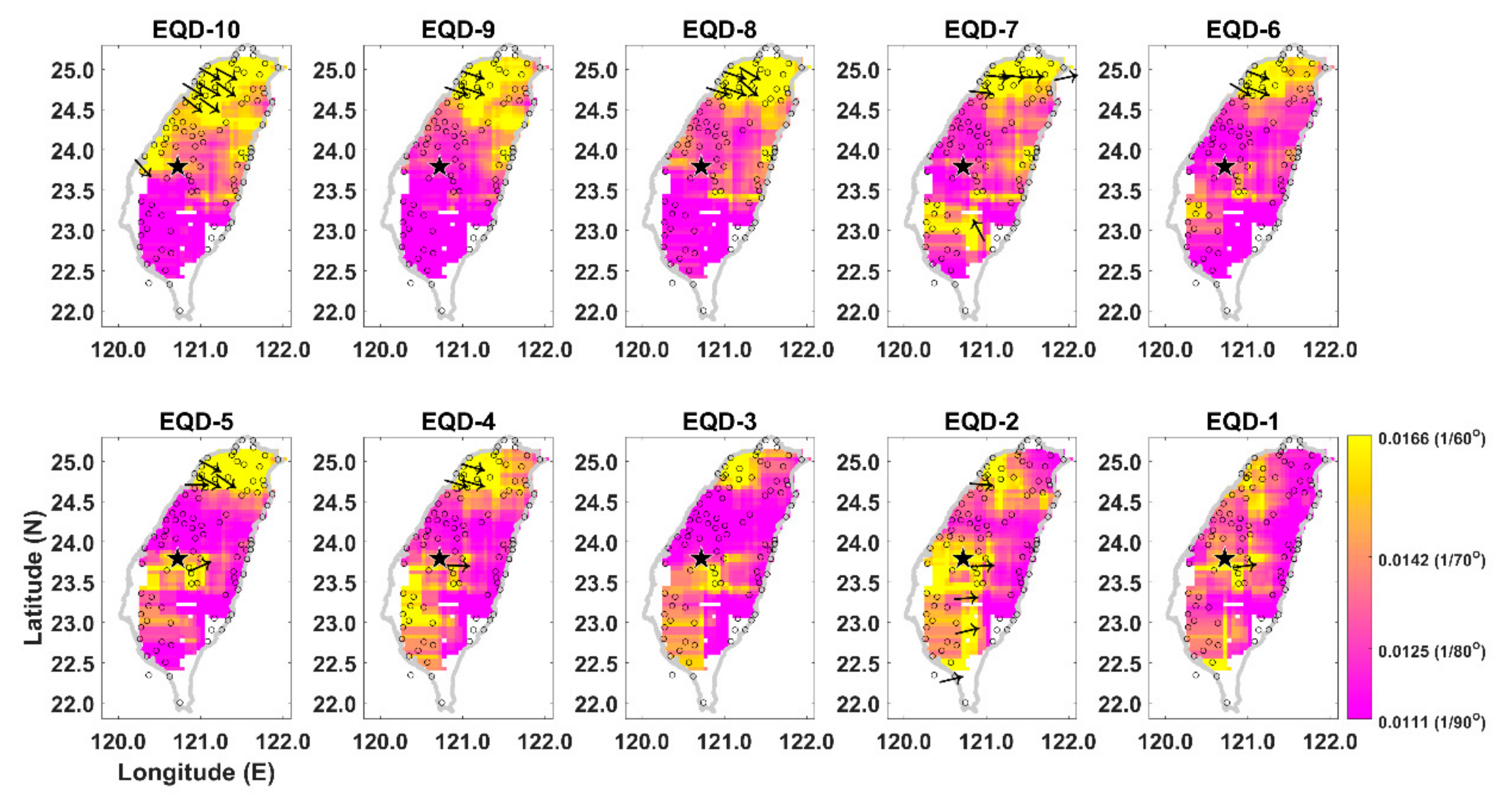

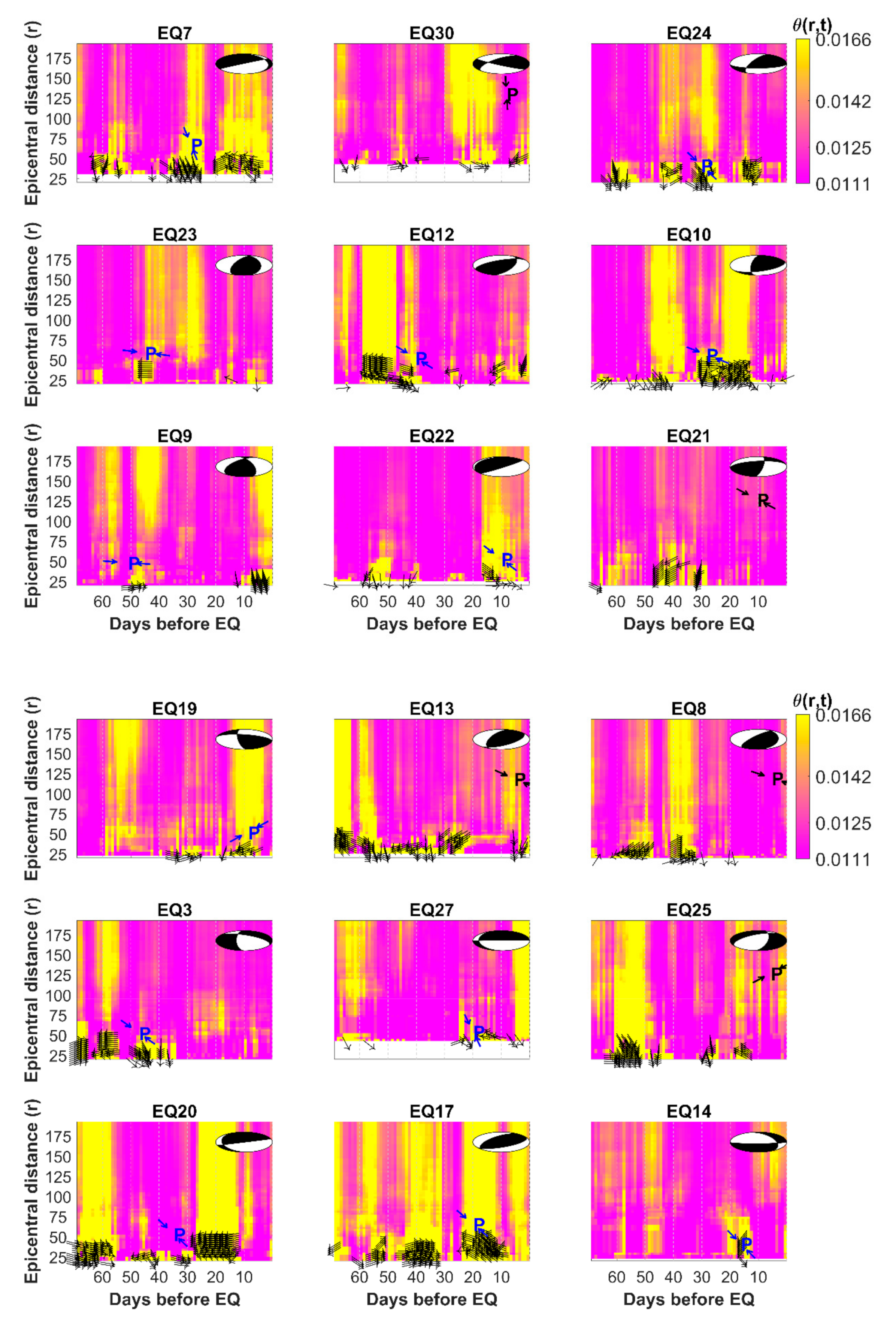
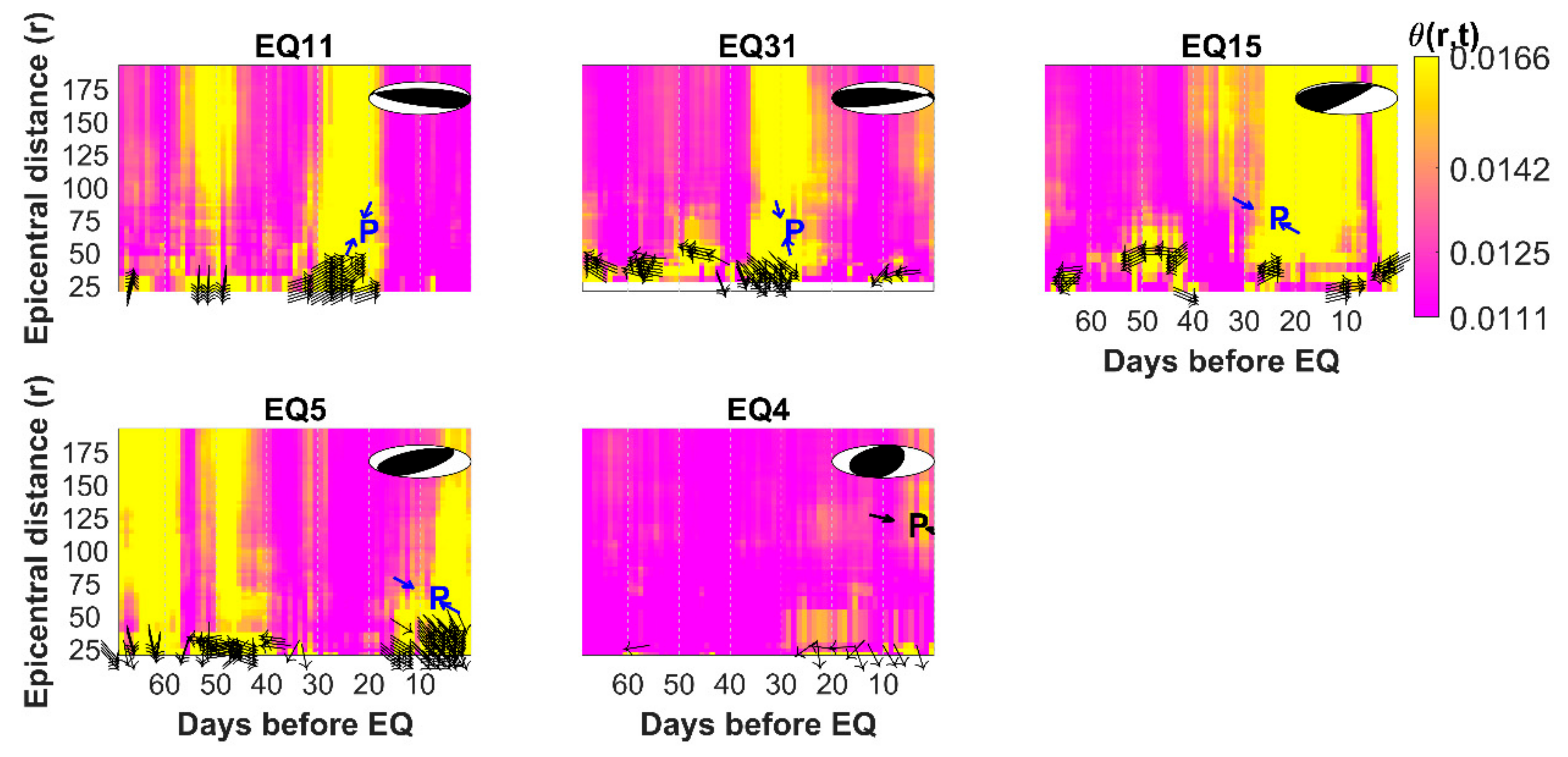
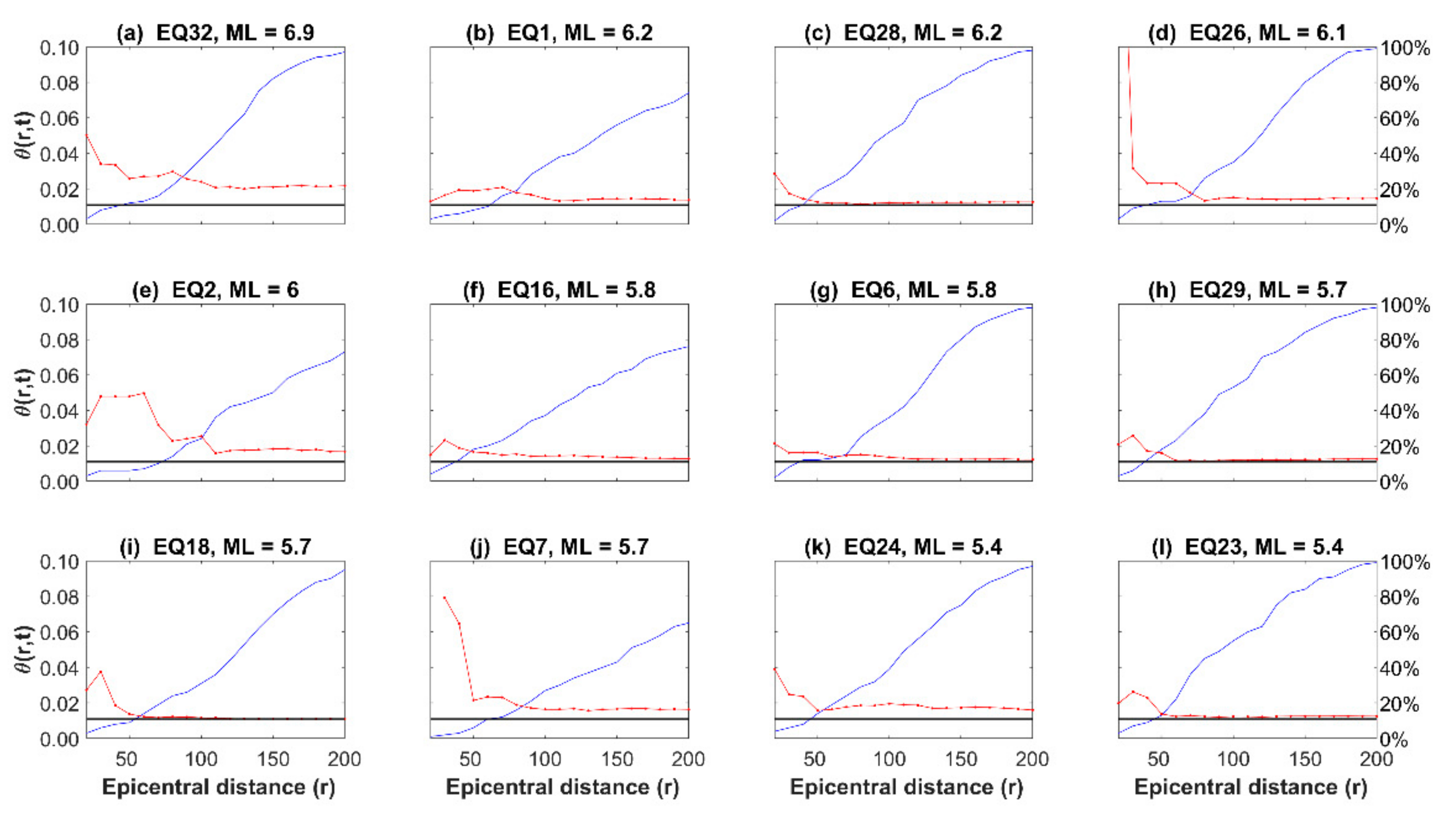
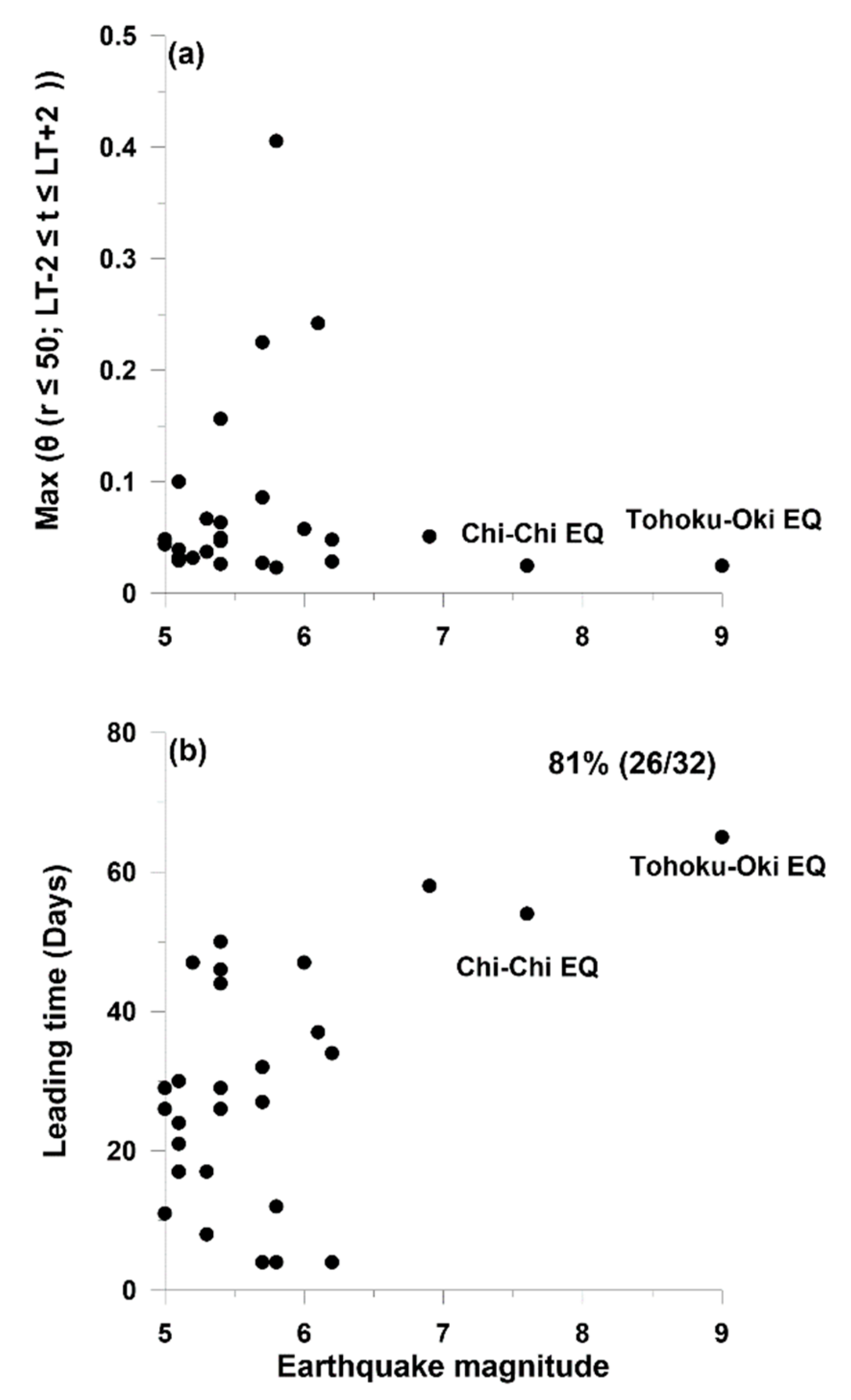
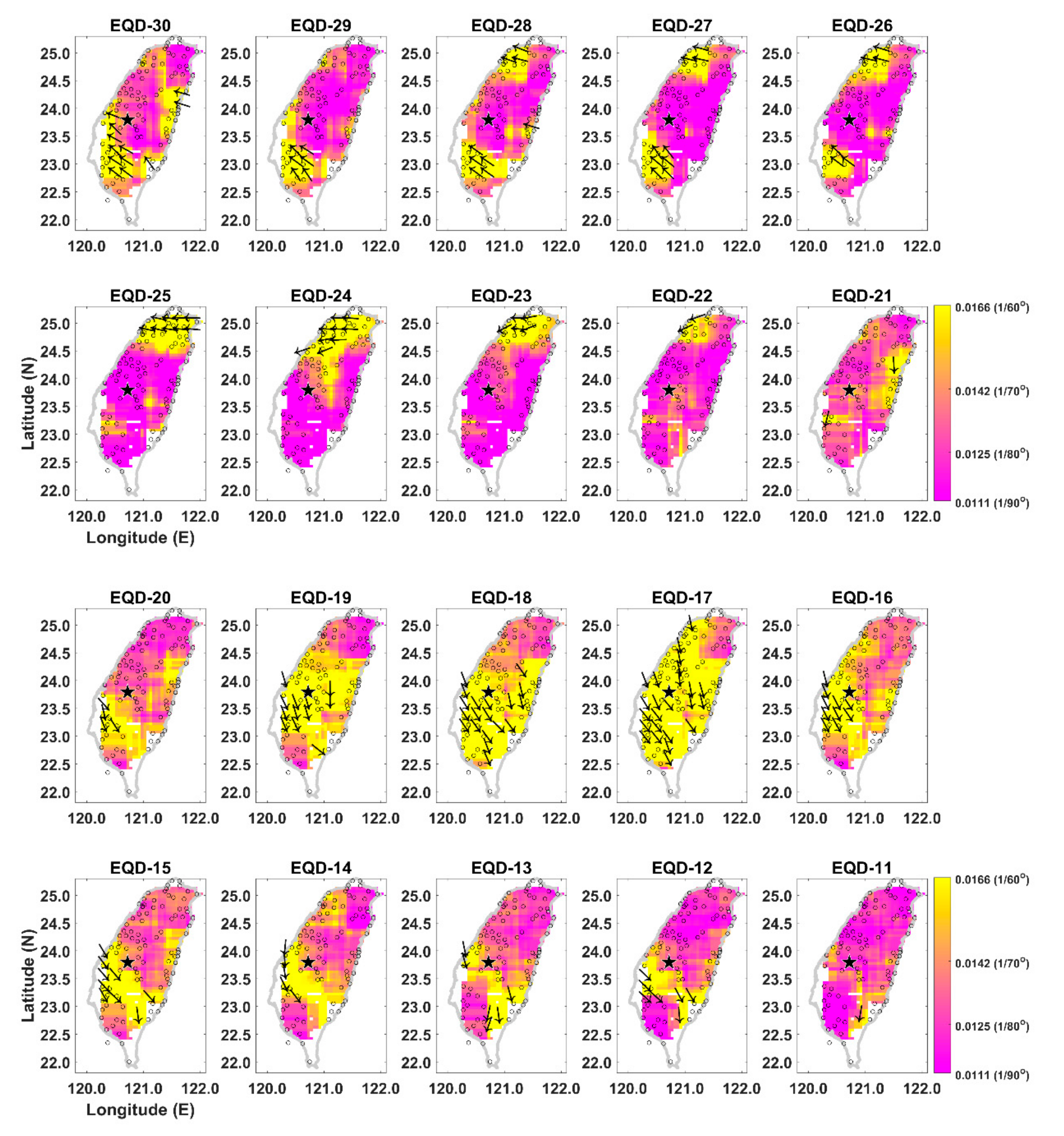
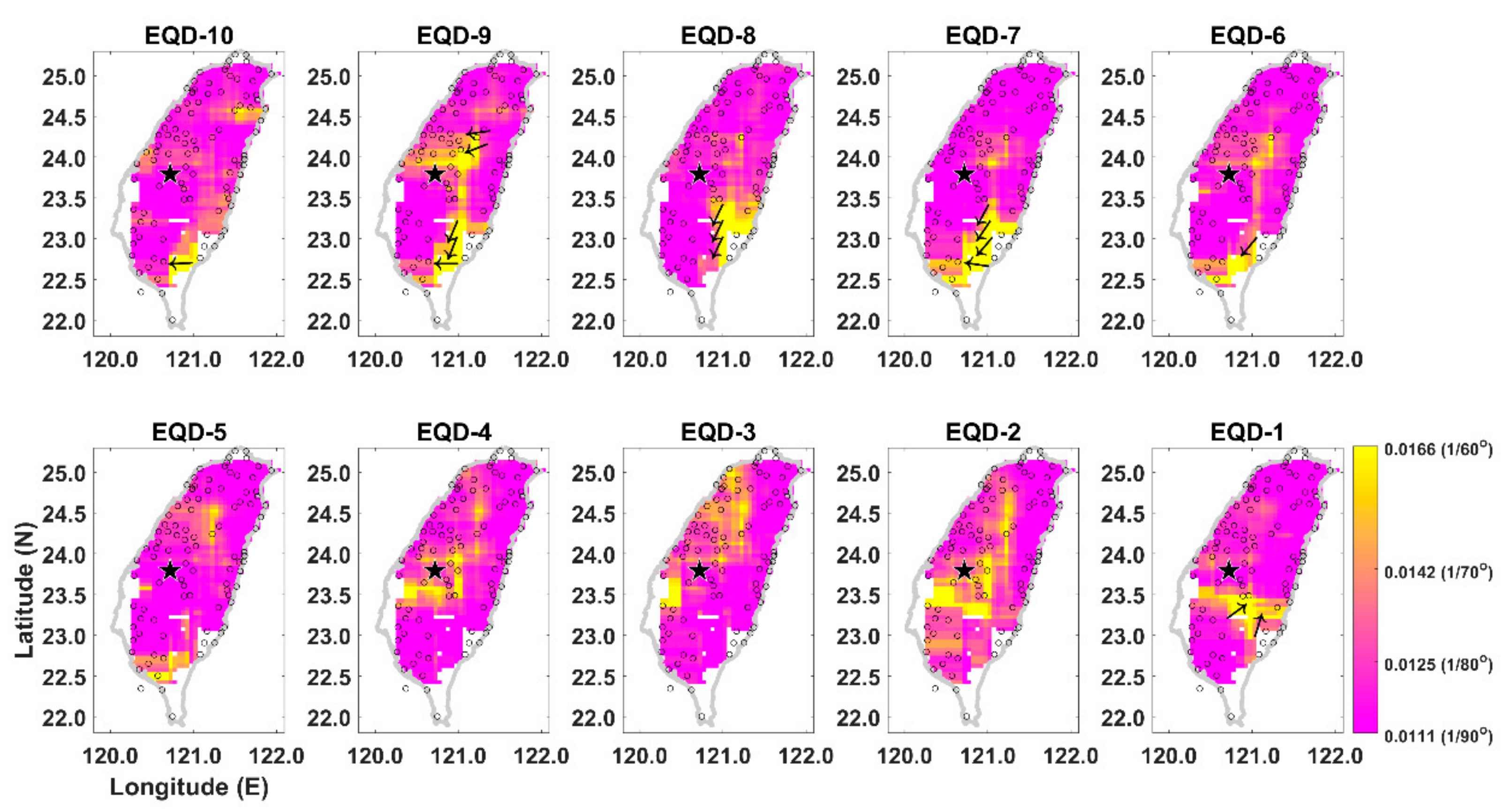
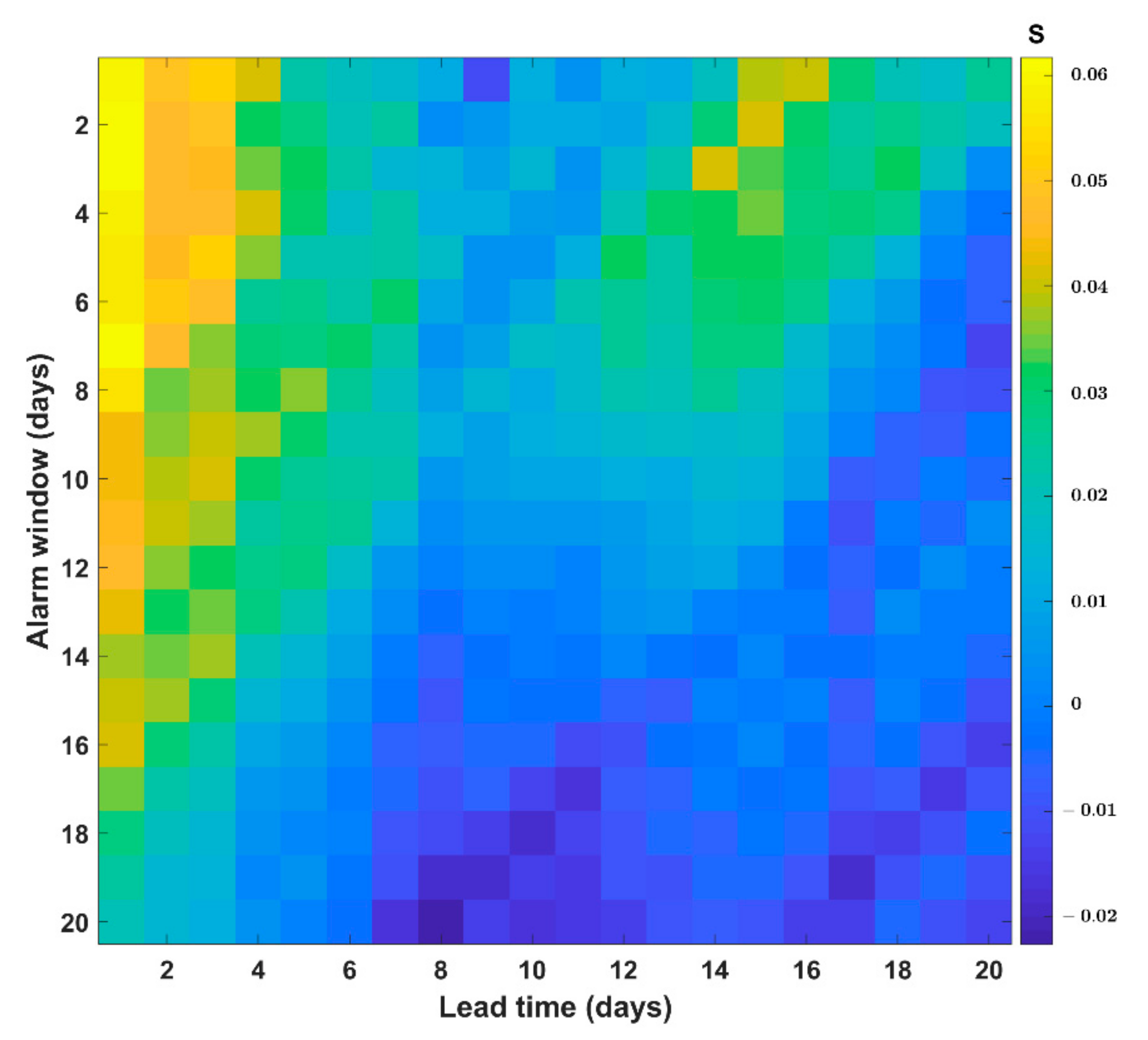

| ID | Time | ML | Longitude (°) | Latitude (°) | θ | LT (Day) | Strike (°) | Dip (°) | Slip (°) | Direction of P axis (°) |
|---|---|---|---|---|---|---|---|---|---|---|
| 1 * | 2006-4-1 10:2:19.54 | 6.2 | 121.081 | 22.884 | 0.0478 | 34 | 193.6 | 58.9 | 30.2 | 141 |
| 2* | 2006-4-15 22:40:55.37 | 6 | 121.304 | 22.856 | 0.0575 | 47 | 214.6 | 46.7 | 116.4 | 106 |
| 3 | 2006-4-28 9:5:26.96 | 5.2 | 121.611 | 23.985 | 0.0316 | 47 | 300.0 | 42.0 | −141.5 | 135 |
| 4 | 2006-6-4 9:6:1.05 | 5 | 121.263 | 22.854 | NaN | NaN | 196.9 | 34.4 | 95.1 | 291 |
| 5 | 2007-7-16 23:42:52.18 | 5 | 121.545 | 23.57 | 0.0485 | 11 | 226.1 | 37.6 | 98.8 | 130 |
| 6 * | 2007-7-23 13:40:2.44 | 5.8 | 121.636 | 23.716 | 0.4056 | 12 | 26.1 | 38.0 | 89.9 | 301 |
| 7 * | 2007-8-9 0:55:47.36 | 5.7 | 121.085 | 22.65 | 0.0860 | 27 | 340.3 | 14.7 | −168.6 | 164 |
| 8 | 2007-10-11 3:5:1.7 | 5.2 | 121.85 | 24.749 | NaN | NaN | 7.4 | 27.1 | 66.5 | 295 |
| 9 | 2007-10-17 14:40:0.03 | 5.4 | 121.612 | 23.501 | 0.0470 | 50 | 210.2 | 41.2 | 125.8 | 95 |
| 10 | 2007-11-28 21:5:13.72 | 5.4 | 121.976 | 24.781 | 0.0637 | 26 | 63.7 | 39.1 | 141.6 | 299 |
| 11 | 2007-12-5 1:41:42.53 | 5.1 | 121.187 | 23.075 | 0.0298 | 24 | 272.3 | 38.5 | 69.7 | 197 |
| 12 | 2008-2-17 20:33:2.32 | 5.4 | 121.461 | 23.307 | 0.1566 | 44 | 240.4 | 47.3 | 119.0 | 130 |
| 13 | 2008-3-4 17:31:47.48 | 5.2 | 120.696 | 23.207 | NaN | NaN | 46.3 | 41.9 | 110.8 | 302 |
| 14 | 2008-4-14 15:39:44.45 | 5.1 | 121.333 | 22.834 | 0.0292 | 17 | 337.9 | 33.9 | −24.8 | 325 |
| 15 | 2008-5-13 18:27:55.34 | 5 | 121.041 | 22.766 | 0.0441 | 26 | 252.8 | 12.6 | 129.6 | 129 |
| 16 * | 2008-6-1 16:59:23.74 | 5.8 | 121.79 | 24.861 | 0.0232 | 4 | 55.2 | 24.2 | 73.4 | 338 |
| 17 | 2008-8-1 18:55:49.32 | 5.1 | 121.526 | 24.048 | 0.1000 | 17 | 219.4 | 44.7 | 75.0 | 140 |
| 18 * | 2008-12-2 3:16:54.23 | 5.7 | 121.486 | 23.338 | 0.2251 | 32 | 232.8 | 42.7 | 126.7 | 118 |
| 19 | 2008-12-23 0:4:43.82 | 5.3 | 120.551 | 22.946 | 0.0371 | 8 | 282.4 | 47.9 | 27.0 | 233 |
| 20 | 2009-1-3 22:4:34.97 | 5.1 | 121.733 | 24.154 | 0.0393 | 30 | 165.5 | 20.3 | 4.4 | 143 |
| 21 | 2009-4-17 12:37:48.89 | 5.3 | 121.682 | 23.917 | NaN | NaN | 260.0 | 40.7 | 156.5 | 126 |
| 22 | 2009-6-28 9:34:56.19 | 5.3 | 121.753 | 24.182 | 0.0667 | 17 | 217.6 | 9.1 | 79.3 | 137 |
| 23 * | 2009-7-26 1:0:12.37 | 5.4 | 120.957 | 23.685 | 0.0262 | 46 | 356.6 | 36.8 | 72.1 | 279 |
| 24 * | 2009-7-26 6:10:59.79 | 5.4 | 121.318 | 23.429 | 0.0497 | 29 | 88.9 | 51.4 | 145.6 | 323 |
| 25 | 2009-8-21 20:57:44.74 | 5.1 | 120.464 | 22.364 | NaN | NaN | 232.5 | 38.5 | −54.0 | 234 |
| 26 * | 2009-10-3 17:36:6.28 | 6.1 | 121.579 | 23.648 | 0.2423 | 37 | 269.6 | 44.4 | 174.9 | 127 |
| 27 | 2009-10-22 23:5:5.13 | 5.1 | 121.488 | 22.685 | 0.0324 | 21 | 172.4 | 19.2 | −7.5 | 161 |
| 28 * | 2009-11-5 9:32:57.66 | 6.2 | 120.719 | 23.789 | 0.0286 | 4 | 228.1 | 59.0 | 150.9 | 100 |
| 29* | 2009-11-5 11:34:21.26 | 5.7 | 120.755 | 23.769 | 0.0273 | 4 | 213.0 | 48.6 | 134.4 | 93 |
| 30 | 2009-11-15 14:47:49.14 | 5.5 | 122.174 | 24.946 | NaN | NaN | 221.8 | 49.6 | 15.9 | 177 |
| 31 | 2009-11-21 17:27:51.26 | 5 | 121.762 | 24.222 | 0.0439 | 29 | 282.8 | 38.5 | 122.4 | 170 |
| 32 * | 2009-12-19 13:2:16.34 | 6.9 | 121.663 | 23.788 | 0.0510 | 58 | 260.0 | 32.1 | 175.1 | 111 |
| IMFs | Median Frequency (Hz) | Median Period (days) |
|---|---|---|
| 1 | 9.9249 × 10−7 | 11.7 |
| 2 | 8.4907 × 10−7 | 13.6 |
| 3 | 1.1127 × 10−6 | 10.4 |
| 4 | 8.6112 × 10−7 | 13.4 |
| 5 | 6.8018 × 10−7 | 17.1 |
| 6 | 4.4520 × 10−7 | 26.0 |
| 7 | 2.8028 × 10−7 | 41.3 |
| 8 | 1.8737 × 10−7 | 61.8 |
| 9 | 1.5120 × 10−7 | 76.5 |
| 10 | 1.0041 × 10−7 | 115.3 |
| 11 | 8.6075 × 10−8 | 134.5 |
© 2020 by the authors. Licensee MDPI, Basel, Switzerland. This article is an open access article distributed under the terms and conditions of the Creative Commons Attribution (CC BY) license (http://creativecommons.org/licenses/by/4.0/).
Share and Cite
Chen, C.-H.; Yeh, T.-K.; Wen, S.; Meng, G.; Han, P.; Tang, C.-C.; Liu, J.-Y.; Wang, C.-H. Unique Pre-Earthquake Deformation Patterns in the Spatial Domains from GPS in Taiwan. Remote Sens. 2020, 12, 366. https://doi.org/10.3390/rs12030366
Chen C-H, Yeh T-K, Wen S, Meng G, Han P, Tang C-C, Liu J-Y, Wang C-H. Unique Pre-Earthquake Deformation Patterns in the Spatial Domains from GPS in Taiwan. Remote Sensing. 2020; 12(3):366. https://doi.org/10.3390/rs12030366
Chicago/Turabian StyleChen, Chieh-Hung, Ta-Kang Yeh, Strong Wen, Guojie Meng, Peng Han, Chi-Chia Tang, Jann-Yenq Liu, and Chung-Ho Wang. 2020. "Unique Pre-Earthquake Deformation Patterns in the Spatial Domains from GPS in Taiwan" Remote Sensing 12, no. 3: 366. https://doi.org/10.3390/rs12030366






